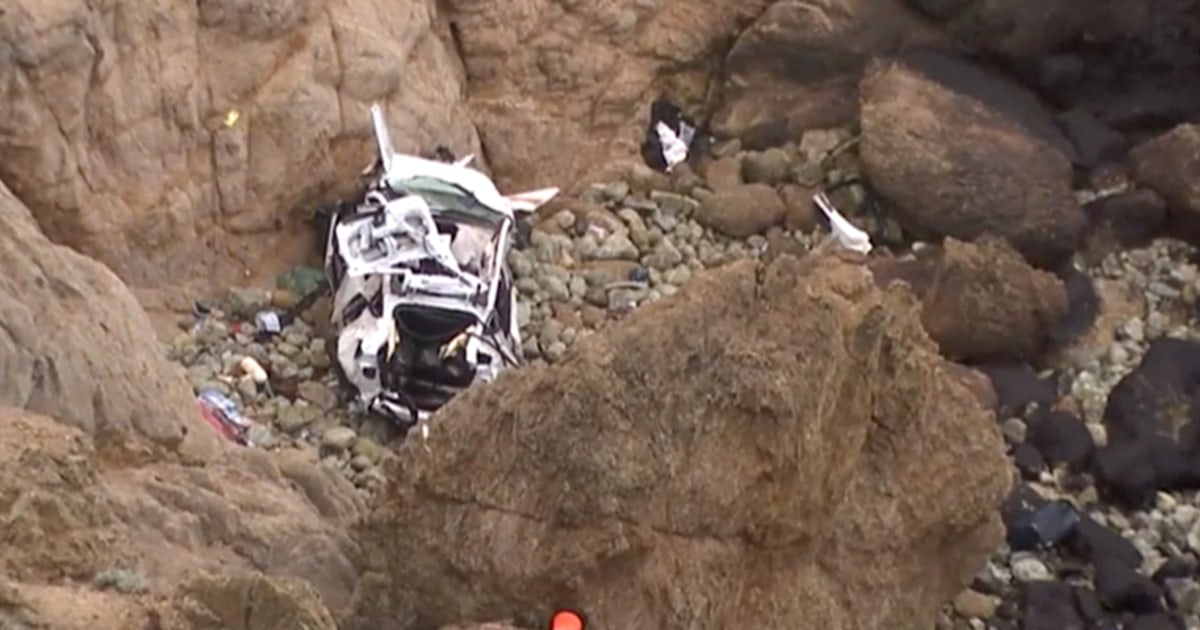
www.nbcnews.com
Unlikely survival of family that plunged off 250-foot California cliff credited to luck, Tesla's design
Survival of California family that plunged 250 feet off cliff due to luck, Tesla's design, experts say
Local
ALAMEDA, Calif. — A California doctor is alleged to have plunged his family hundreds of feet down a coastal cliff in what authorities have described as a murder attempt, but their improbable survival is likely because of luck and a well-built vehicle, experts said.
Dharmesh Patel, 41, is accused of barreling a Tesla Model Y off Devil’s Slide, a roughly 250-foot cliff 20 miles south of San Francisco, on Monday morning, the California Highway Patrol said.
Images captured by a rescue team showed the battered SUV right-side up, perched precariously on a rocky ledge just above the Pacific Ocean.
Jingwen Yu, a professor of mechanical engineering at the University of Michigan’s Transportation Research Institute, said their survival was a “kind of a miracle, considering the impact severity.”
“The driver probably underestimated how safe a vehicle could be, which provided us ‘hope’ for vehicle safety,” Yu said in an email.
Patel, a 41-year-old woman and two children ages 4 and 7 — both of whom were in car seats — were in the SUV, Highway Patrol spokesman Mark Andrews said.
Andrews declined to specify their conditions Thursday. He said all remained hospitalized.
It isn’t clear how fast Patel was driving when the vehicle left the scenic stretch of Highway 1 at roughly 11 a.m. Nor is it clear what driving mode Patel was using before the SUV careened off the cliff, the Highway Patrol said.
"However, that does not appear to be a contributing factor in this incident," it said Tuesday.
Flipped 'several' times
In a video from the scene, Brian Pottenger, the San Mateo Santa Cruz battalion chief for the California Department of Forestry and Fire Protection, said the SUV "flipped several times" on its way down.
It isn't clear whether it struck the cliffside as it fell.
An expert on accident reconstruction, Jose Granda, a professor of mechanical engineering at California State University, Sacramento, said he doesn't believe it flipped — computer simulations show it couldn't have, he said — nor does he believe it smashed into the cliffside.
If it had, Granda said, the roof would have completely collapsed and killed everyone inside. After having analyzed imagery of the damaged vehicle, he said it appeared the roof was intact with a piece of the SUV’s back door on top of it.
In Granda’s view, the SUV is likely to have plunged at speeds topping 80 mph — a fast fall that was most likely blunted by pebblelike rocks and sand. He compared the landing pad to a ball pit at Chuck E. Cheese.
"You have the reason why these people are alive," he said.
The batteries in the vehicle’s undercarriage most likely kept the vehicle from tilting forward, as a car with an engine under the hood would have, he said.
To Yu, the SUV appeared to have struck the cliffside as it tumbled toward the ocean.
“Rollover” incidents tend to be far more lethal than front-end or side crashes, Yu said. While the images showed a vehicle that had suffered major damage, Yu said its integrity appeared to have remained intact.
“The occupants still have a survival space,” he said. “That’s remarkable.”
Yu pointed to the SUV’s roof strength and seat belt design. He also said its low center of gravity — the batteries are in the undercarriage — may have helped it land on its wheels instead of its roof.
The Insurance Institute for Highway Safety, a nonprofit research and educational organization, has given the Tesla Model Y top safety scores since it was introduced in 2020, a spokesman said.
But the organization’s chief research officer, David Zuby, cautioned that no carmaker prepares for an event like the one on Devil’s Slide.
“In my 35 years of working on vehicle safety, I’ve never had an automaker say, 'Look at this crash test we’re doing for extra credit,'” he said. “No car you could go buy today is designed to protect the driver when they drive off a cliff like that.”
Their survival, he said, was "mostly luck."
Safety improvements over the years
Still, Zuby said, cars have generally become safer in the last three decades. They're built with stronger materials, like high-strength steel and a better-designed "safety cage," or the area that protects a car's occupants.
Those improvements mean people are less likely to die in wrecks than they were in the 1970s and the 1980s, Zuby said.
“People are wearing seat belts more than they were 30 years ago,” he said. “That for sure or likely played a role in those people’s survival.”
Whether it was a seat belt, luck or the Model Y's well-built roof, Pottenger said, while rescue workers were developing a recovery plan, through binoculars they noticed someone moving in the SUV's front seat.
"It was very shocking," he told NBC News NOW. "We did not expect that. It really turned my mind into a different avenue, that this is not a recovery — this is an active rescue."
Helicopters were dispatched, and the family was hoisted from the vehicle using rescue baskets, he said.
Authorities haven’t identified a motive. Patel, who works at Providence Holy Cross Medical Center in Los Angeles, will be booked into the San Mateo County Jail on attempted murder and child abuse charges after he is released from the hospital, the Highway Patrol said.
It isn't clear whether Patel has a lawyer. In a statement, the hospital said it was "deeply saddened to learn of a traffic incident involving one of our physicians and his family,” adding, “We are extremely grateful there were no severe injuries."
The hospital declined to comment further.
























































